Cameroon foods play a crucial role in Cameroon’s cultural identity. They are unique in cooking style, taste and aromas. Besides being one of the most delicious cuisines in Africa, Cameroon foods are quite nutritious as well. Let’s deep dive into what I call the A to Z of Cameroon foods.
Achu
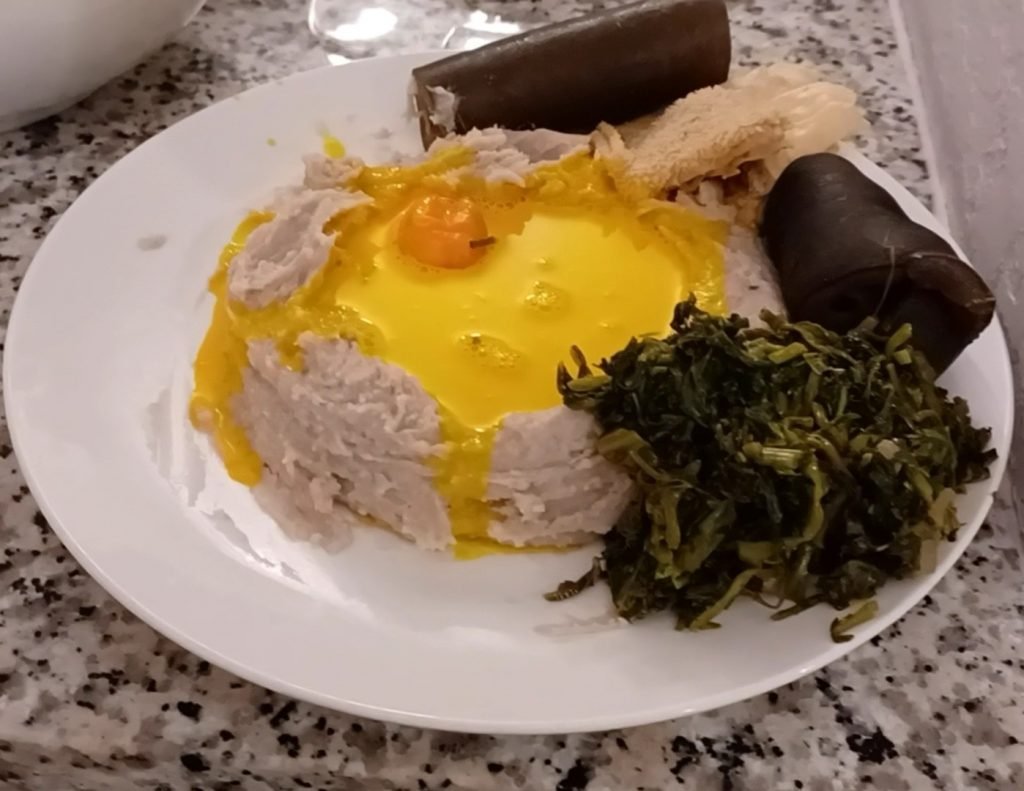
Achu is a meal that consists of pounded taro (Colocasia esculenta) and a yellow soup that is made of meat broth, limestone (also called kanwa), palm oil, and some traditional spices. It is the traditional dish of the Mankon people of the Northwest Region, but now widely consumed throughout the country.
Taro is a good source of dietary fiber which helps ease digestion (1). Taro contains resistant starch (a type of carbohydrate) that helps to keep the heart healthy by lowering cholesterol (bad fat) in the blood (2).
Bobolo
Bobolo is a food made from fermented cassava (Manihot esculenta). It is popularly consumed everywhere in Cameroon, because it makes a good accompaniment for many vegetable dishes, sauces, and grilled fish.
The fermentation process helps to extend the shelf life of bobolo, making it one of the easiest of Cameroon foods to store; bobolo can last for many days at room temperature.
Cassava roots are a good source of vitamin C (20mg of vitamin C in every 100g of cassava). This provides about 20% of the amount of daily intake of vitamin C recommended by FDA (Food and Drug Administration) (3).
Besides, cassava is a good source of resistance starch that helps our digestive system work well (4).
Cornchaff
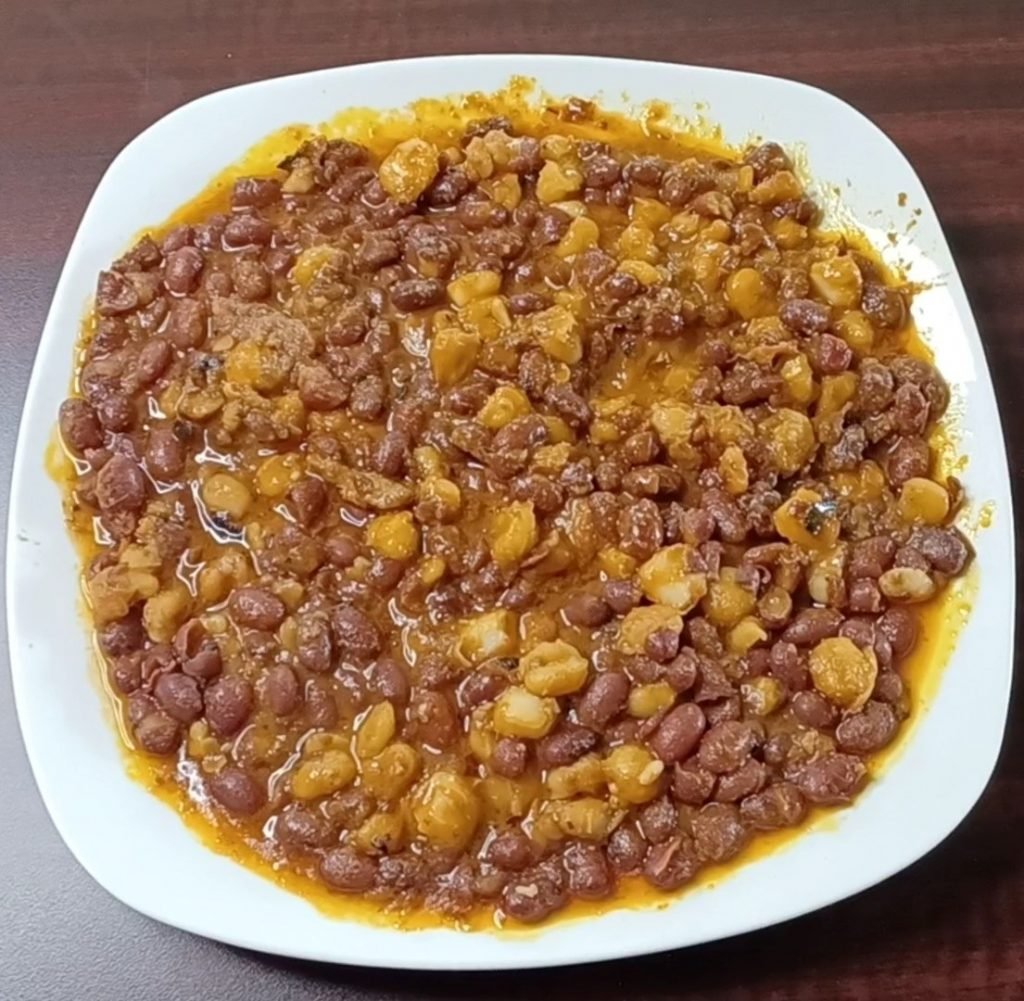
Cornchaff is a meal porridge made with corn (Zea mays), beans (Phaseolus vulgaris) and palm oil. It is a staple meal eaten weekly in many homes and sold by many food vendors on the streets and in the markets.
Cornchaff is eaten at least twice a week in many boarding schools like Saker Baptist College, Limbe, my alma mater.
Beans is a rich source of protein that the body needs for growth and repair damaged cells and tissues (5). Moreover, beans contains adequate amounts of vitamin B9 (folate) which helps our body cells to develop and grow well (6).
Dodo
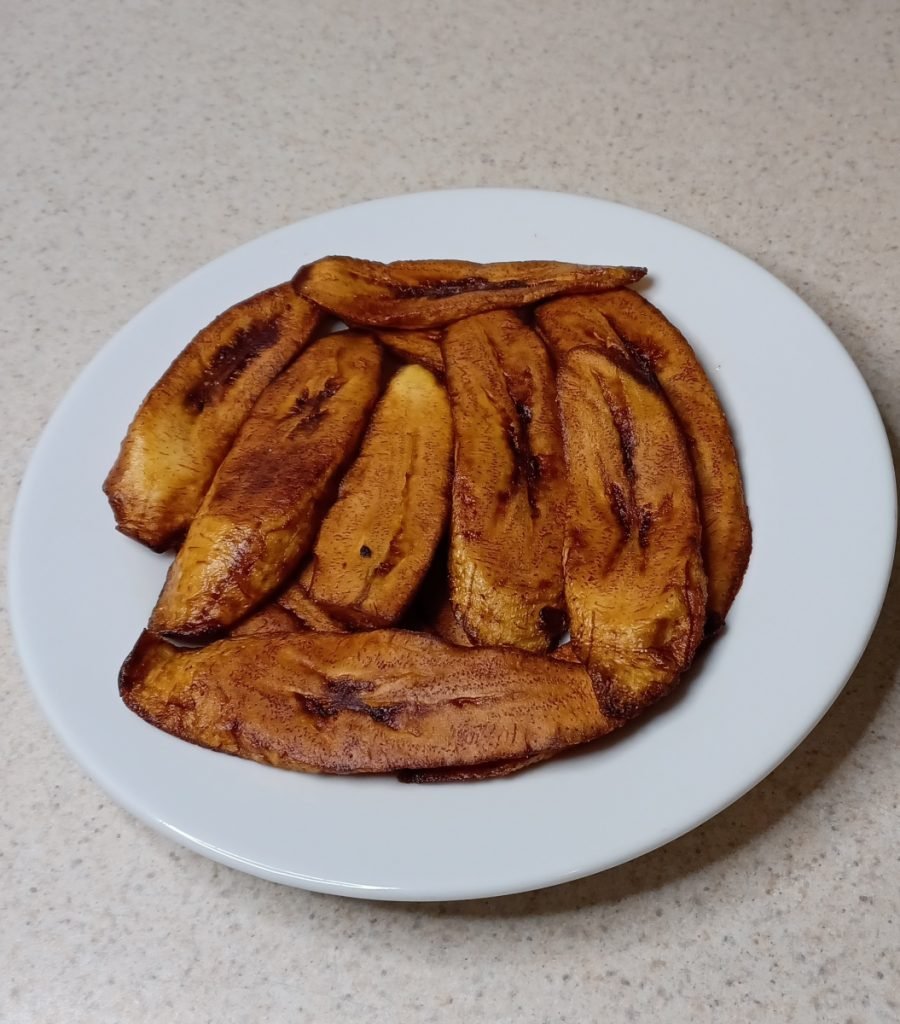
Dodo is fried ripe plantain (Musa spp.). It serves as an accompaniment to many sauces, vegetable dishes, and grilled meats. It is also commonly eaten for breakfast together with fried eggs.
Plantains is rich in fiber, vitamin C and potassium. Potassium helps our heart, nerves, and muscles to function well, and a diet rich in potassium may help the body to balance sodium and consequently reduce blood pressure (7).
Eru
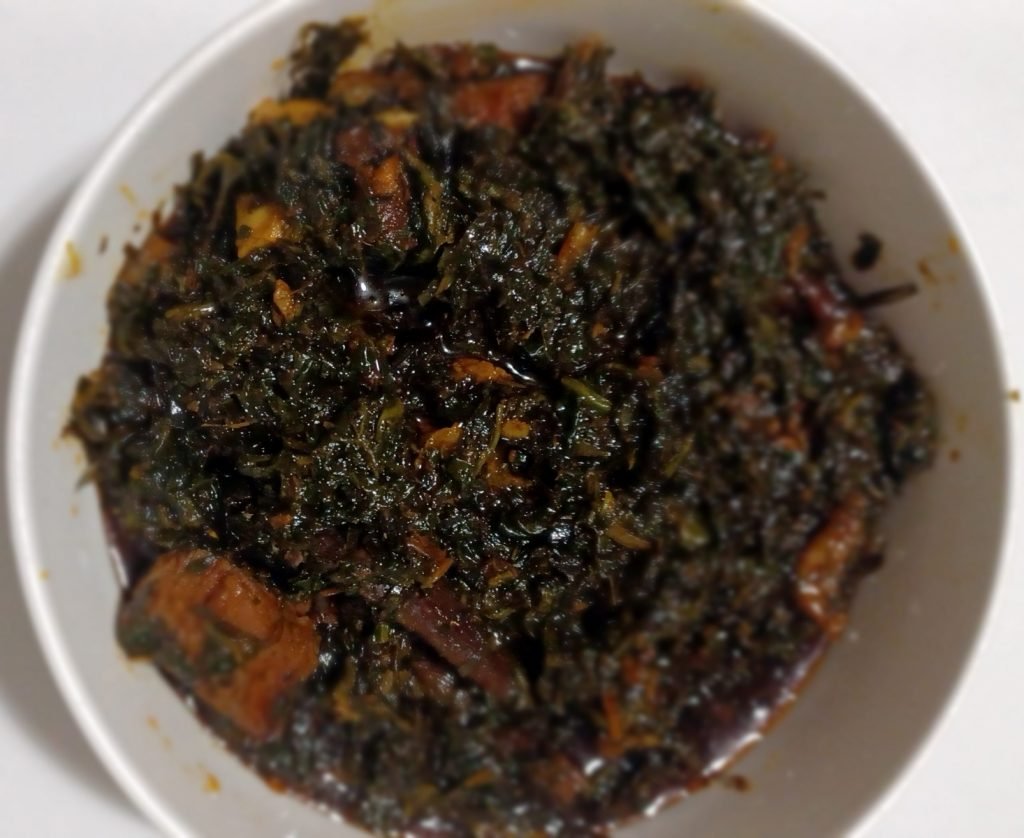
Eru is vegetable dish made with eru (Gnetum africanum), waterleaf (Talinum triangulare), meats, dry fish, crayfish, and palm oil. It is eaten with either water fufu (cooked cassava paste) or garri (fried cassava grits).
Eru is an excellent source of fiber, the reason why eru has been consumed for ages as a laxative and remedy for constipation. Fiber is not digested, so it draws water from the intestines and makes stool soft so it can easily be passed out (8).
Fufu corn
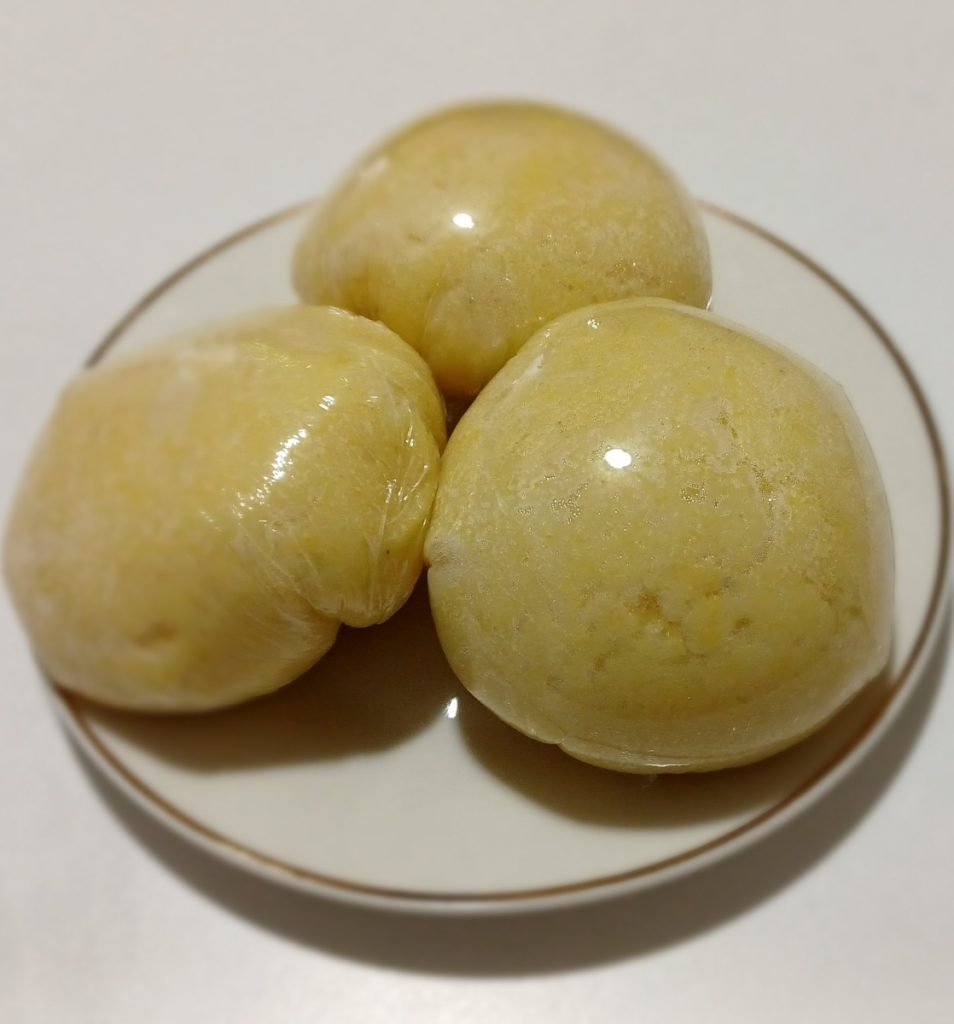
Fufu corn is cooked yellow or white corn (Zea mays) flour. It is a side dish eaten with vegetable dishes like “njama-njama” (Solanum scabrum), as well as other soups.
Yellow corn contains adequate amounts of vitamin C, that aids to strengthen the body’s immune system. Furthermore, yellow corn contains substances called carotenoids that help our eyes function well (9).
Garri
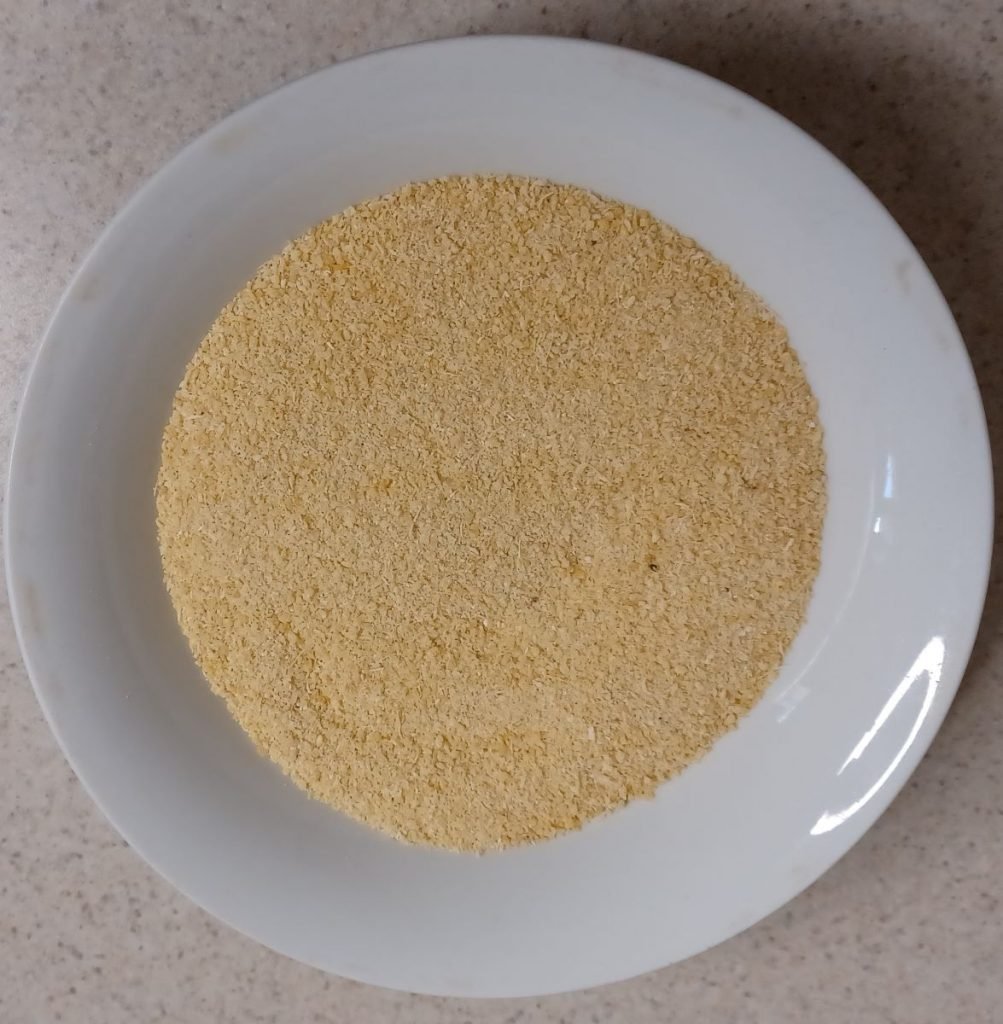
Garri is fermented fried cassava grits which is either yellow (fried with palm oil added) or white (fried without palm oil added). It can be eaten alone as soaked garri, which is prepared by simply pouring cold water into a bowl of garri, and adding sugar (roasted grounduts and even milk can also be added). Garri can also be cooked in hot water and served alongside soups, and vegetable dishes like eru.
To process garri, cassava is peeled, washed, grated, fermented, pressed (to drain out excess water), sifted, fried, cooled, sieved (or further ground) and then packaged.
Garri has almost no fat (0.4g of fat per 1 cup of garri) and is very rich in fiber (7g of fiber per 1 cup of garri), which is good for digestion (10).
Hotpot
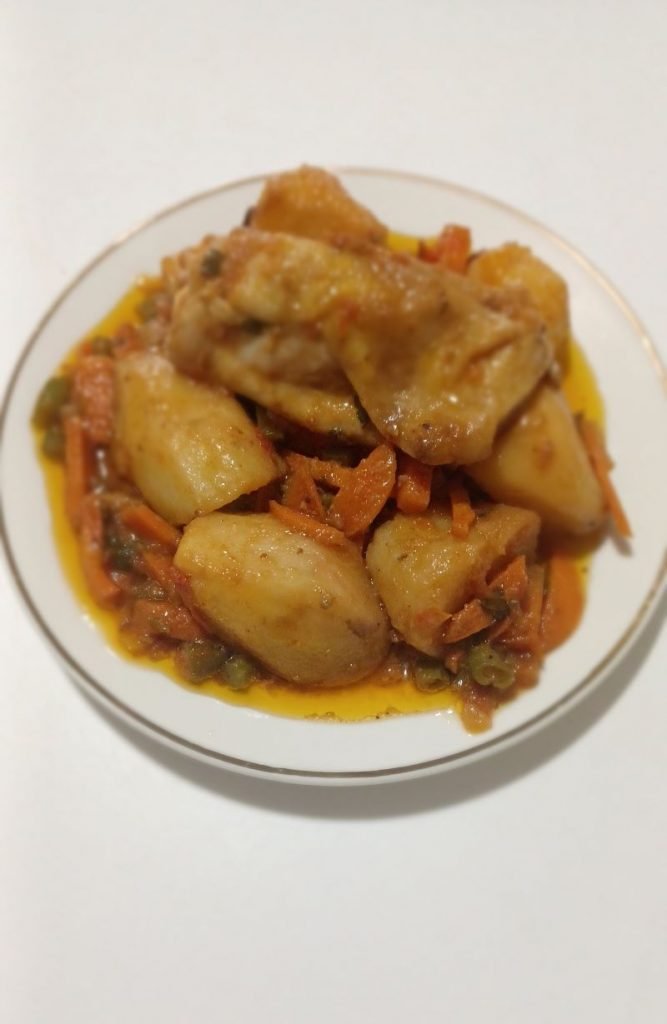
Hotpot is a dish made with Irish potatoes (Solanum tuberosum), and tomatoes. Meat, fish and vegetables like carrots, green beans, green peppers, leeks, and others can also be added to hotpot.
Irish potato is rich in potassium which is good for the nerves and heart. Potassium also enables the body control our blood pressure (11).
Itoko
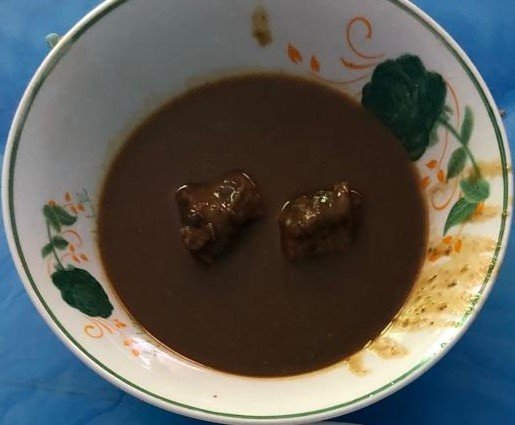
Itoko is a black soup made with ibaba seeds (which are black in color), palm oil and local spices. It is served alongside taro fufu or water fufu (cooked cassava paste).
Palm oil is a good source of vitamin E, which helps to protect the brain cells from damage. Farther, it contains carotenoids that help the body make vitamin A. Vitamin A promotes healthy eyes and improves eyesight (12).
Jellof rice
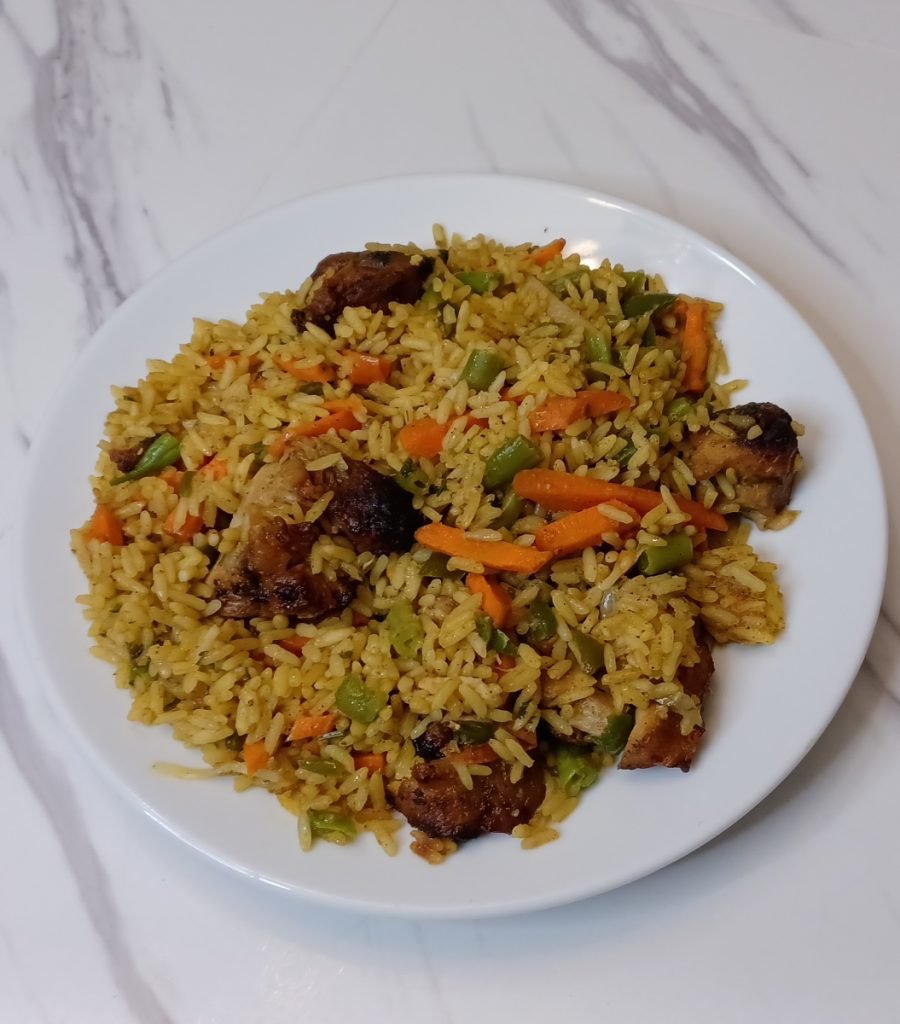
Jellof rice is a rice cooked with tomatoes, carrots, and green beans. It is one of the Cameroon foods you will find in any party, because it is the favorite of children. Meat, fish, or chicken can be used to cook jellof rice.
Rice is a rich source of carbohydrates which is the main source of energy that the body needs to carry on its main tasks. Rice is also a good source of magnesium which help our muscle contract properly for good body movement (13).
Kokki
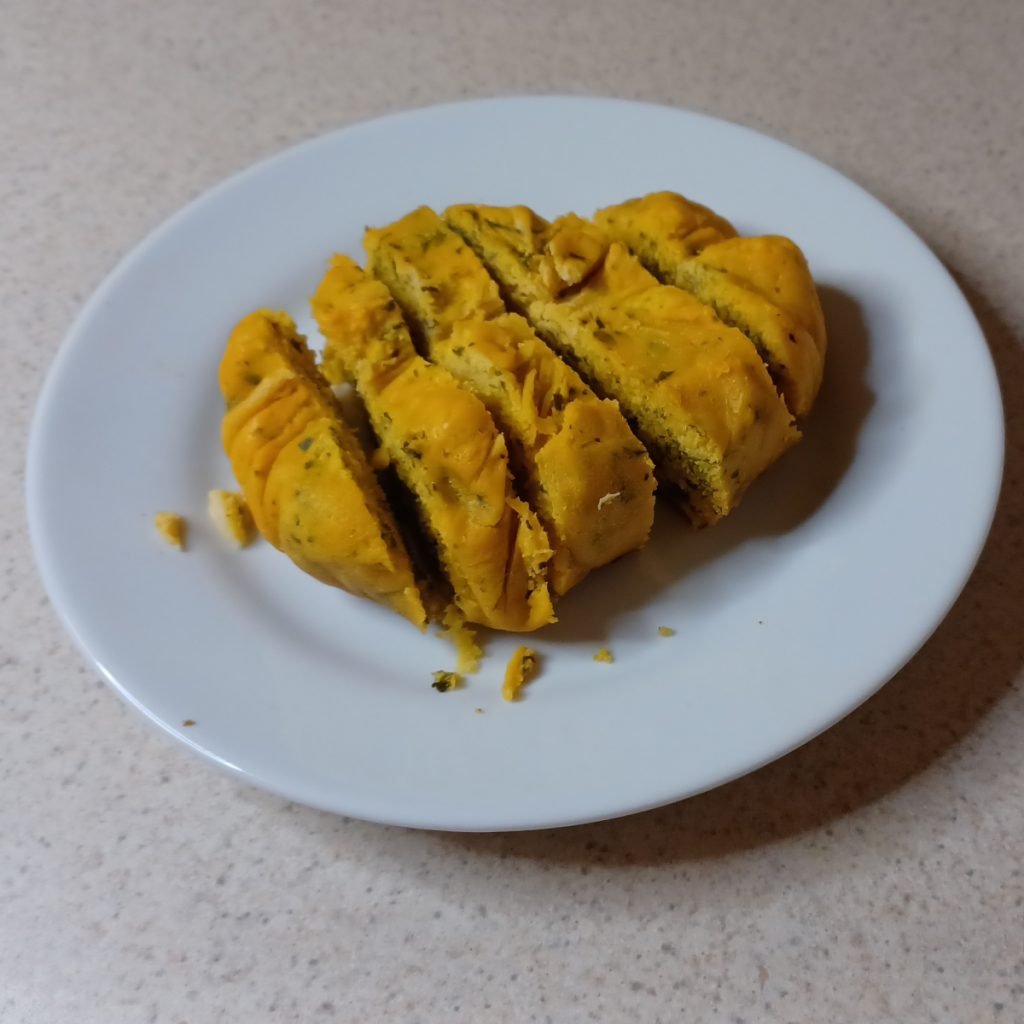
Kokki is a steamed bean cake made from blended black eye beans (Vigna unguiculata). It is eaten together with boiled plantains, taro, cassava, or potatoes.
Black eyed beans are rich in fiber, vitamin A, vitamin B9, and manganese. Manganese enables good blot clotting and also enhances the proper development of bones (14).
Liver Sauce
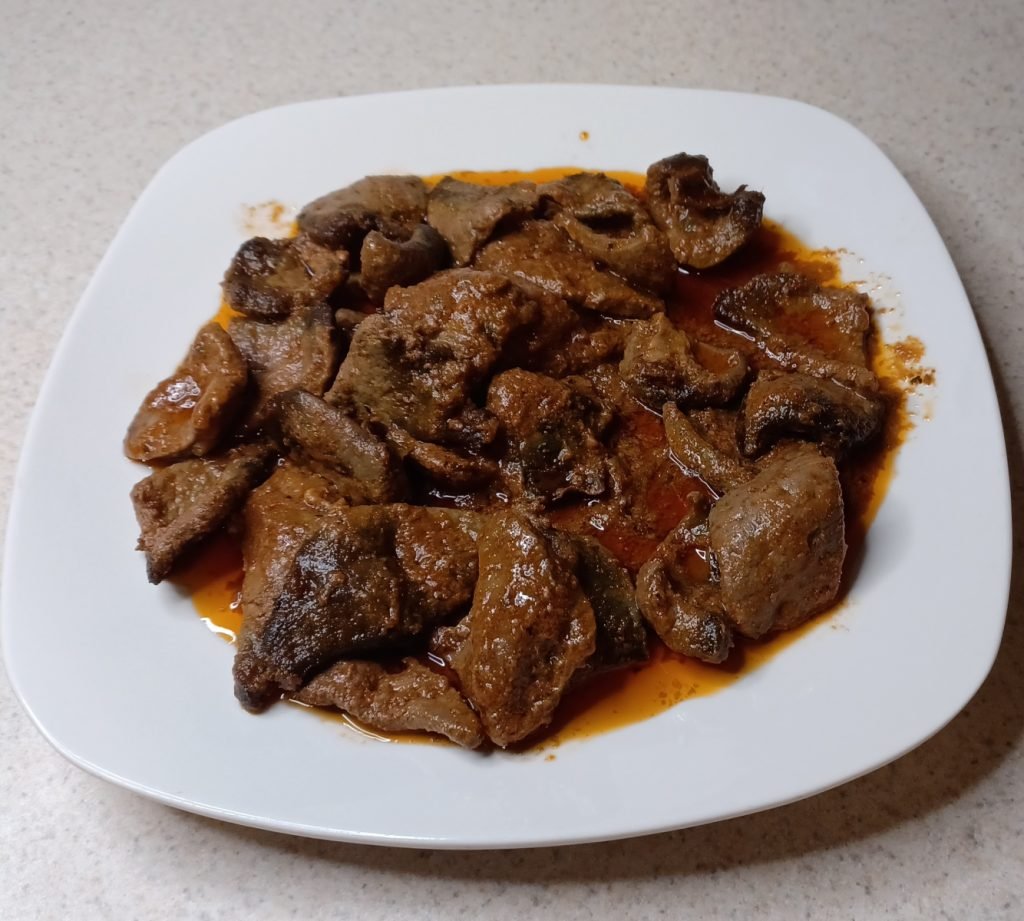
Liver sauce is a kind of sauce prepared with tomato sauce and cow’s liver. It is commonly is eaten with rice, boiled plantains, boiled potato, or dodo.
Liver is rich in iron, which the body needs to produce blood. Iron is also very important for the proper development of the brain and growth generally in children (15).
Miondo
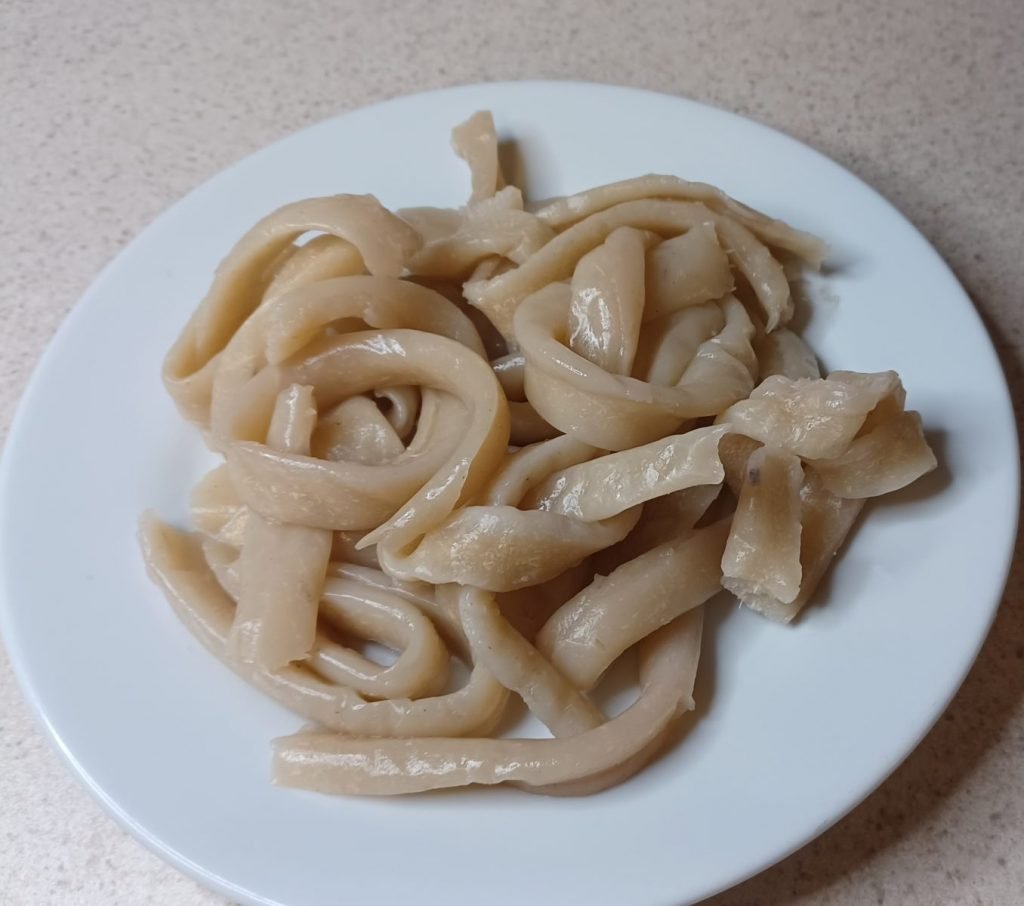
Miondo is fermented cassava wrapped in banana leaves. It is much slimmer in size than bobolo and appears like thin sticks. It is the perfect accompaniment for grilled meats, vegetable dishes and sauces.
Cassava contains a decent amount of vitamin C: 20.6mg of vitamin C per 100g of cassava, which is about 34% of the recommended daily value for vitamin C per day (3).
Vitamin C is needed for the production of collagen, the protein that makes the skin tough and bouncy. Collagen also protects the skin from damage, and helps the skin heal quickly when its wounded. Farther, collagen promotes the development and growth of strong bones (16).
Ndole
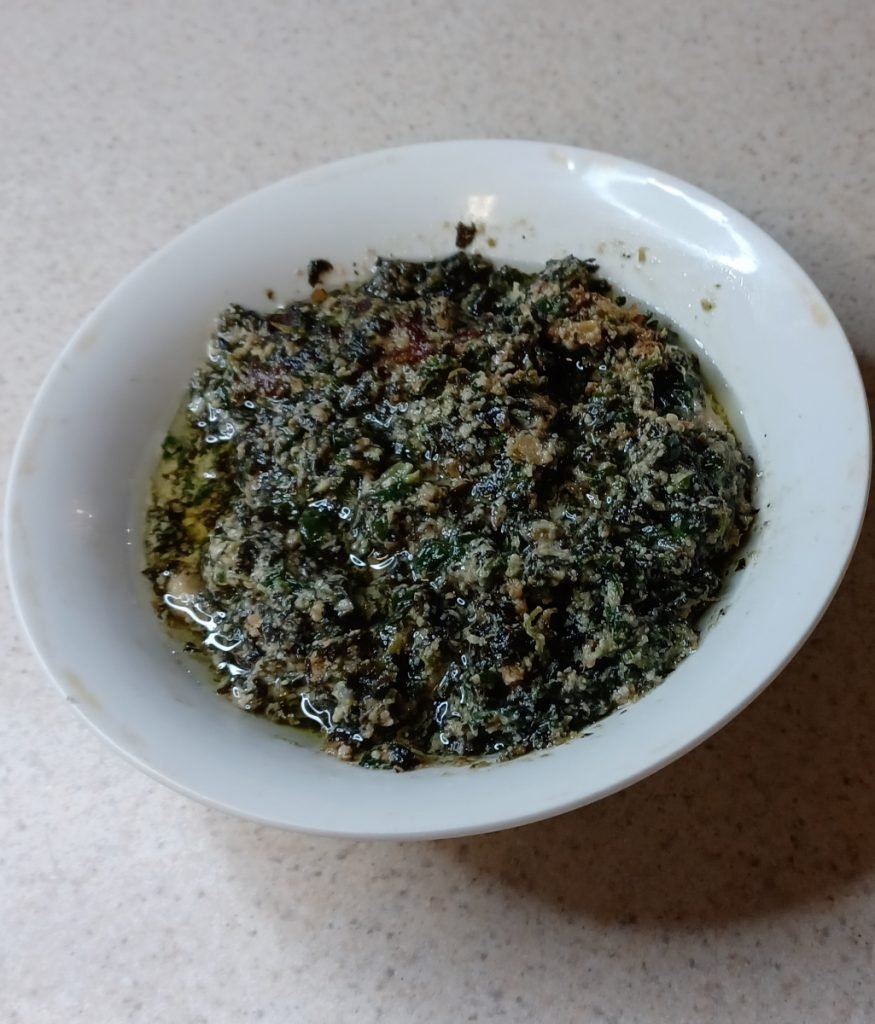
Ndole is a vegetable dish made with bitter leaf (Vernonia amygdalina) and peanut (Arachis hypogaea) whose skin has been peeled off (locally called white groundnut). It is often eaten with bobolo, miondo, boiled plantains, dodo, boiled cassava, boiled Irish potatoes, fufu corn and boiled yam.
Peanut is rich in protein and good fats, which help to lower cholesterol. High cholesterol levels in the body can cause heart disease, heart attack, and even stroke (17). Bitter leaf contains compounds that help to detoxify the body and reduce stress (18).
Okro soup
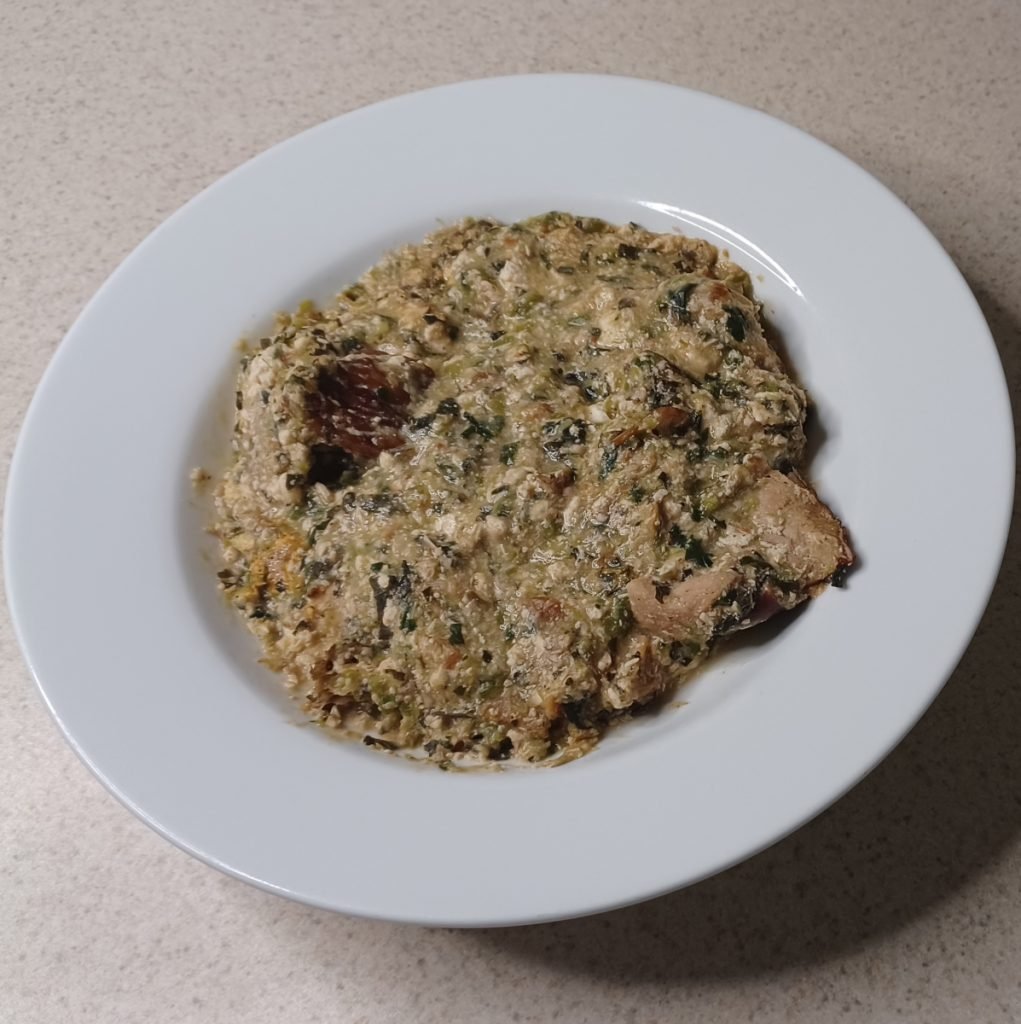
Okro is a soup made with okra (Abelmoschus esculentus), egusi/melon seeds (Cucumeropsis mannii) and palm oil. It can also be cooked without palm oil, and in this case, it’s called plain okro. Okro is eaten with water fufu, garri, and fufu corn.
Okra is a good source of vitamin A which promotes good eye sights, and Vitamin C which helps to strengthen our immune system. When our immune system is strong, we do not get sick easily as the body is able to fight germs that cause sicknesses better (19).
Puff puff

Puff puff is a snack made with all-purpose flour, sugar, salt, and baker’s yeast. It is the most popular street food sold in every region of Cameroon. It is popularly eaten with red kidney beans, or pap (fermented corn flour porridge), tea or chili pepper sauce.
All-purpose flour is a rich source of carbohydrates is the body’s main source of energy (20). Flour also contains iron which helps the brain develop well (15).
Roasted fish
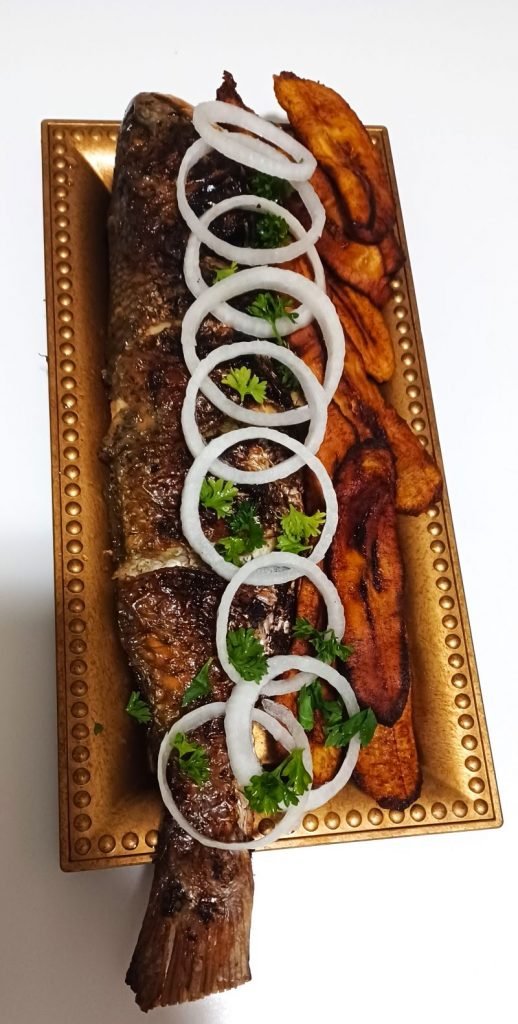
Roasted fish is spiced fish that is grilled over charcoal. It is a nighttime street food sold in almost every neighborhood in Cameroon. It is one of the Cameroon foods that tourists like a lot as it is prepared and served in many beaches that tourists visit when they are in Cameroon.
The horse mackerel (Trachurus trachurus), and tilapia (Tilapia zillii) are the most popular fish species that are roasted every night in Cameroon. Roasted fish is eaten with bobolo, dodo, miondo, roasted plantains, and tapé tapé (flattened fried ripe plantains).
Fishes such as horse mackerel and tilapia are excellent sources of vitamins A, D, and B12. The horse mackerel is particularly very rich in omega -3 fatty acid, a very good fat that helps our heart and brain function very well (22).
Soya
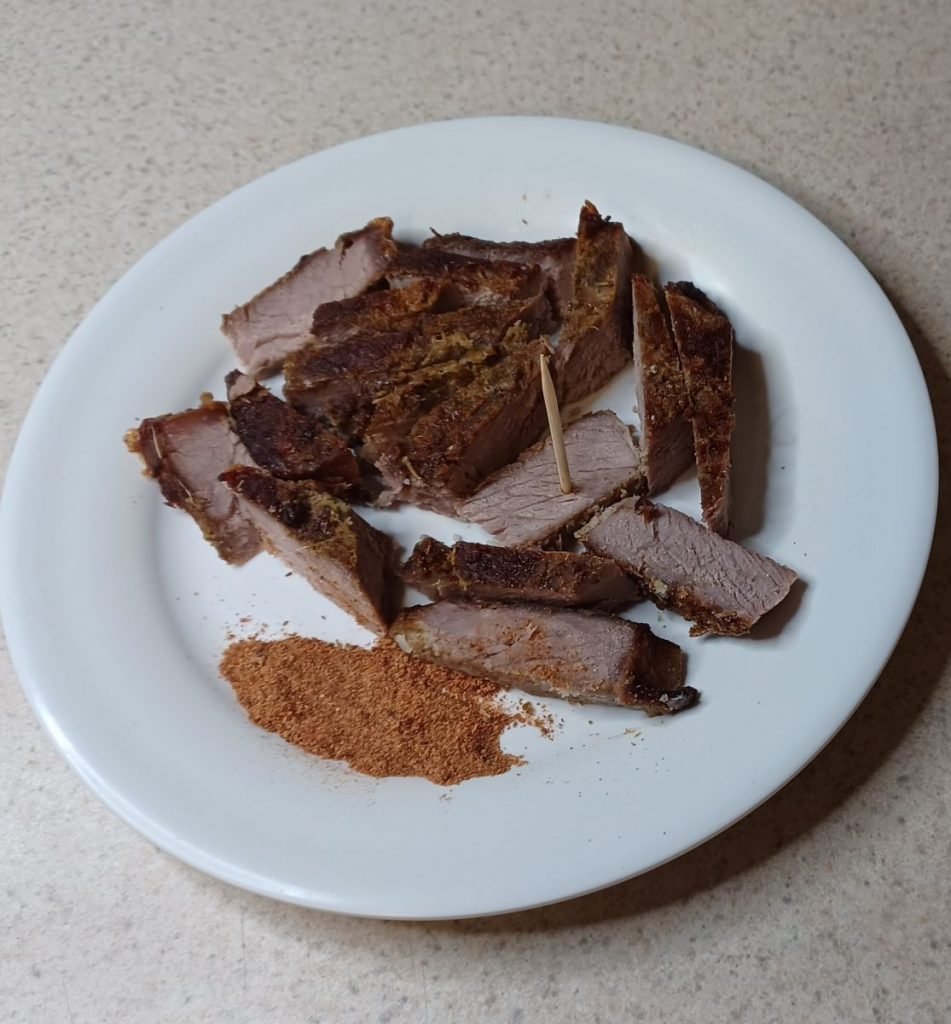
Soya is cow meat that is grilled either in brochettes, as a whole lump that is later chopped into smaller pieces before it is served. It is another very common street food enjoyed by Cameroonians and it is commonly served with powder chili pepper (soya pepper) and toothpick for an easy pick and eat. Soya can also be eaten with roasted ripe plantains.
Meat is an excellent source of protein, and red meat is particularly rich in iron, zinc, and B vitamins. Zinc helps wounds heal faster, reduces swelling, and helps our sense of taste and smell (23).
Tanchot soup
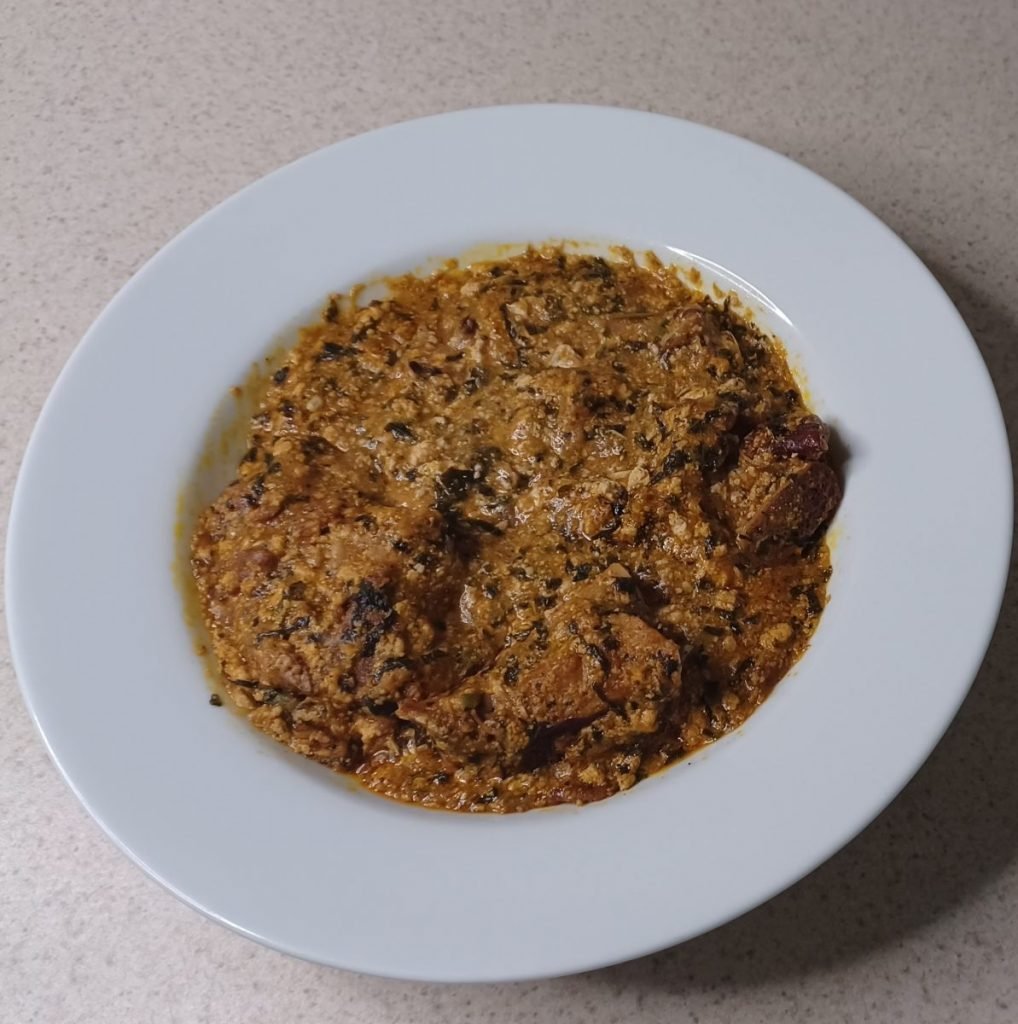
Tantchot soup is an ethnic soup made from ogbono seeds (Irvingia gabonensis), egusi, tanchot leaves (also called bush pepper leaves) okra, and palm oil. It is native to the Bayangi people of the South West Region, and it is often eaten with water fufu or garri.
Ogbono seeds are rich in fiber which may help lower cholesterol in the blood. Also, ogbono may help with weight loss as some research studies have shown that extracts from the seeds cause fats to breakdown more and reduce the growth of fat cells (24).
Water fufu
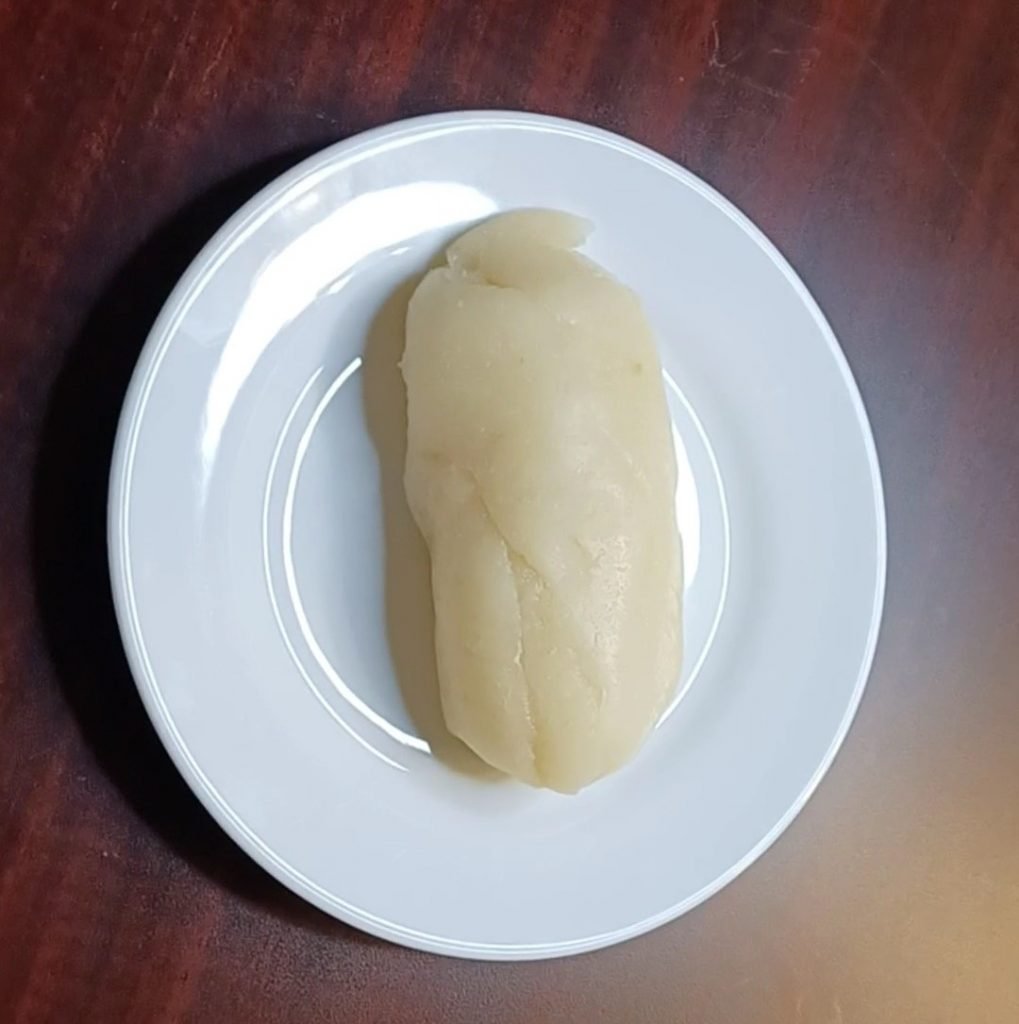
Water fufu is cooked fermented cassava grits. It is the perfect accompaniment for eru, and soups like tanchot and okro soup. Water fufu is sold already fermented and just ready to be cooked.
Cassava is rich in fiber which is not digested by our human enzymes. Fiber goes to our large intestines intact where it serves as food for healthy bacteria that leave there. These bacteria feed on fiber and grow in numbers and phase out harmful bacteria that can cause diseases. Therefore, fiber contributes to strengthening our immune system (25).
Yam
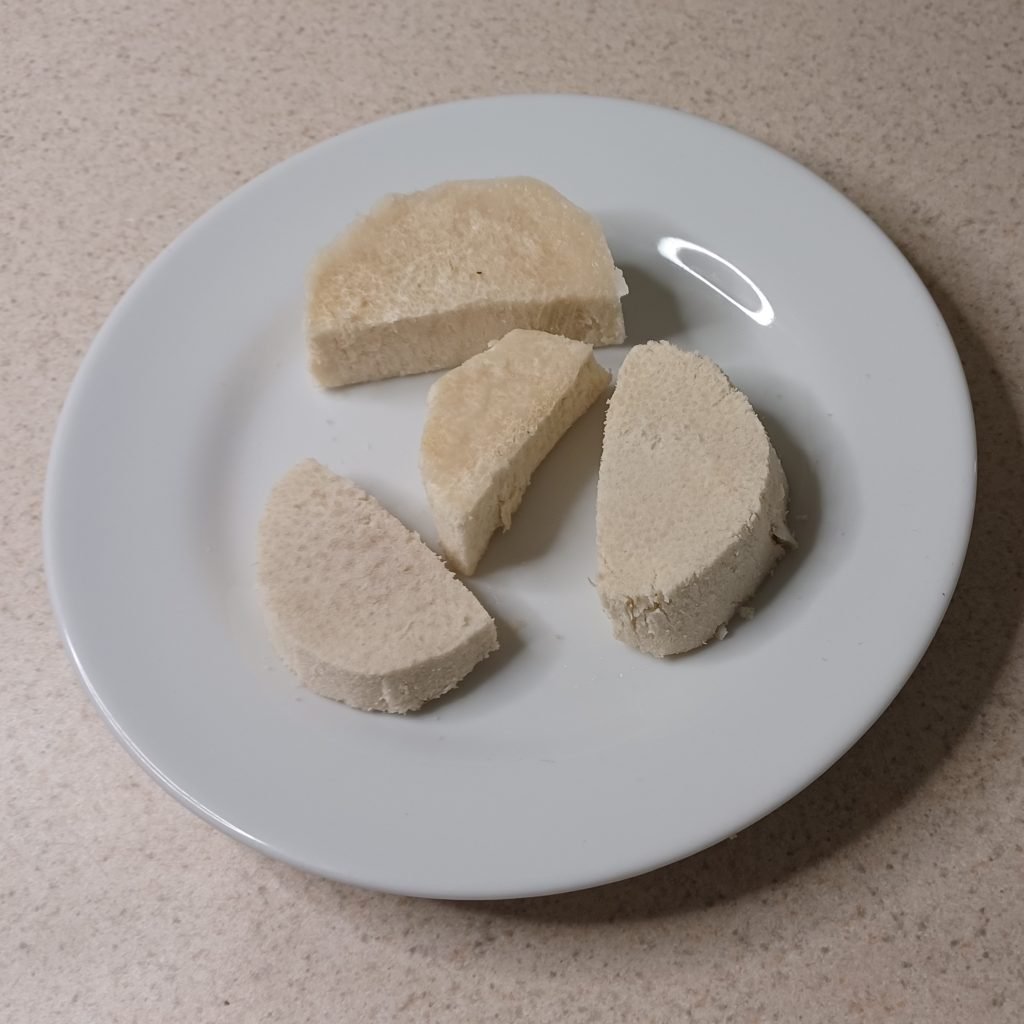
Yam is a the edible starchy root of the plant Dioscorea rotundata. It consumed as an accompaniment to many vegetable dishes (like ndole), sauces and soups.
Yam is a good source of vitamin C, B vitamins and fiber. It also contains a good amount of minerals like copper which is vital to produce red blood cells and manganese which the body needs to form bones, and clot blood well (26).
Zom
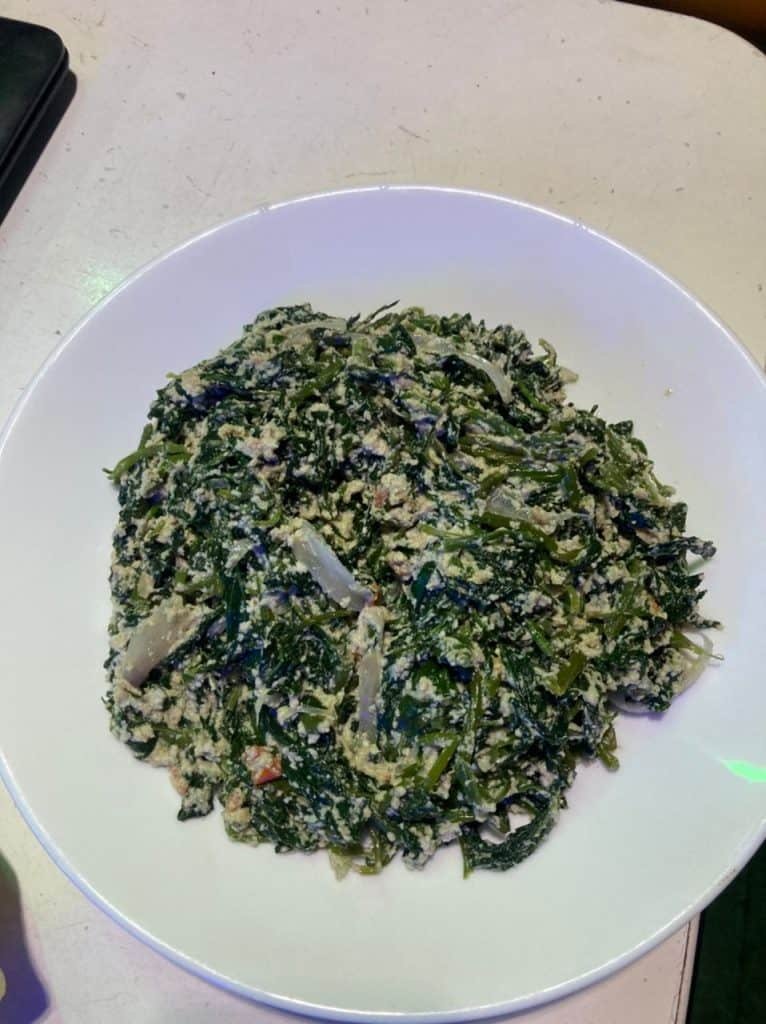
Zom is a vegetable dish made with large size huckleberry or African nightshade (Solanum scambrum) leaves and egusi. It is native to the people of the Center Region and is commonly eaten with water fufu.
Solanum scambrum contains high amount of certain substances called antioxidants which protect the body cells from damage and protect our DNA from toxins. Moreover, it contains decent amounts of vitamin C, iron, and vitamin B2 which, boosts our immune system, and promotes good cell growth and function (27).
Missing letters of Cameroon Foods
At the moment, there are no known Cameroon foods starting with letters U, V and X. Therefore, my able team is still searching and we would be pleased to know in the comment section if you do have any information on them.
Abc Phonics Song on Cameroon Foods
I composed a “Phonics Song” with all these Cameroon foods to help educate kids on how to pronounce the foods properly. You and your kids can therefore enjoy this beautiful song in my YouTube channel by clicking the video below.
Abc Phonics Book
I was also inspired by this song to write a book for kids that is now live on Amazon. The “Abc Food Phonics Book For Kids” will teach your children the alphabet using these yummy delicacies. Farther, this nutrition information is broken down to make it easy for them to comprehend.
Conclusion
The Cameroonian cuisine is so wide and varied, with so many food combinations. For example, with Cameroon foods, a household can conveniently make a whole month’s menu with a different meal everyday.
Cameroon foods are noted for being spicy as chili pepper is a main component of almost every dish. Also worth noting is the fact that palm oil is popularly used to cook most traditional Cameroon foods.
References
- FoodData Central. (n.d.). Usda.Gov. Retrieved February 24, 2023, from https://fdc.nal.usda.gov/fdc-app.html#/food-details/169308/nutrients
- Higgins, J. A. (2004). Resistant starch: metabolic effects and potential health benefits. Journal of AOAC International, 87(3), 761–768. https://doi.org/10.1093/jaoac/87.3.761
- FoodData Central. (n.d.). Usda.Gov. Retrieved February 24, 2023, from https://fdc.nal.usda.gov/fdc-app.html#/food-details/169985/nutrients
- Chisenga, S. M., Workneh, T. S., Bultosa, G., & Alimi, B. A. (2019). Progress in research and applications of cassava flour and starch: a review. Journal of Food Science and Technology, 56(6), 2799–2813. https://doi.org/10.1007/s13197-019-03814-6
- FoodData Central. (n.d.). Usda.Gov. Retrieved February 24, 2023, from https://fdc.nal.usda.gov/fdc-app.html#/food-details/173744/nutrients
- Ajmera, R., MS, & RD. (2020, February 27). 15 Healthy Foods That Are High in Folate (Folic Acid). Healthline. https://www.healthline.com/nutrition/foods-high-in-folate-folic-acid
- Richards, L. (2020, October 5). Plantains: Benefits and nutrition. Medicalnewstoday.Com. https://www.medicalnewstoday.com/articles/plantain-benefits
- Ogbonnaya, E. C., & Chinedum, E. K. (2013). Health promoting compounds and in vitro antioxidant activity of raw and decoctions of Gnetum aficanum Welw. Asian Pacific Journal of Tropical Disease, 3(6), 472–479. https://doi.org/10.1016/s2222-1808(13)60103-6
- Corn. (n.d.). WebMD. Retrieved February 24, 2023, from https://www.webmd.com/food-recipes/corn-health-benefits
- Garri – 1 cup. (n.d.). Nutritionix. Retrieved February 24, 2023, from https://www.nutritionix.com/i/nutritionix/garri-1-cup/5849b126ac0f0aa95e238490
- Good Food Is Good Medicine. (n.d.). Potato health benefits and why you should eat more spuds. Good-Food. Retrieved February 24, 2023, from https://health.ucdavis.edu/blog/good-food/potato-health-benefits-and-why-you-should-eat-more-spuds/2022/05
- FoodData Central. (n.d.). Usda.Gov. Retrieved February 24, 2023, from https://fdc.nal.usda.gov/fdc-app.html#/food-details/171015/nutrients
- Ms, B. C., RD, CDCES, & CDN. (n.d.). White Rice Nutrition Facts and Health Benefits. Verywell Fit. Retrieved February 24, 2023, from https://www.verywellfit.com/rice-nutrition-facts-calories-and-health-benefits-4119792
- Manganese. (n.d.). Mount Sinai Health System. Retrieved February 24, 2023, from https://www.mountsinai.org/health-library/supplement/manganese
- Iron. (2019, September 16). The Nutrition Source. https://www.hsph.harvard.edu/nutritionsource/iron/
- Pullar, J., Carr, A., & Vissers, M. (2017). The roles of vitamin C in skin health. Nutrients, 9(8), 866. https://doi.org/10.3390/nu9080866
- Health Benefits of Peanuts. (n.d.). WebMD. Retrieved February 27, 2023, from https://www.webmd.com/diet/health-benefits-peanuts
- Farombi, E. O., & Owoeye, O. (2011). Antioxidative and chemopreventive properties of Vernonia amygdalina and Garcinia biflavonoid. International Journal of Environmental Research and Public Health, 8(6), 2533–2555. https://doi.org/10.3390/ijerph8062533
- Vitamin A and Carotenoids. (n.d.). Nih.Gov. Retrieved February 27, 2023, from https://ods.od.nih.gov/factsheets/VitaminA-Consumer/
- FoodData Central. (n.d.). Usda.Gov. Retrieved February 27, 2023, from https://fdc.nal.usda.gov/fdc-app.html#/food-details/535538/nutrients
- C. Onodu, B., J. Culas, R., & U. Nwose, E. (2018). Facts about dietary fibre in cassava: Implication for diabetes’ medical nutrition therapy. Integrative Food Nutrition and Metabolism, 5(3). https://doi.org/10.15761/ifnm.1000216
- Domingo, J. L., Bocio, A., Falcó, G., & Llobet, J. M. (2007). Benefits and risks of fish consumption Part I. A quantitative analysis of the intake of omega-3 fatty acids and chemical contaminants. Toxicology, 230(2–3), 219–226. https://doi.org/10.1016/j.tox.2006.11.054
- Zinc. (2020, November 17). Mayo Clinic. https://www.mayoclinic.org/drugs-supplements-zinc/art-20366112
- Ngondi, J. L., Oben, J. E., & Minka, S. R. (2005). The effect of Irvingia gabonensis seeds on body weight and blood lipids of obese subjects in Cameroon. Lipids in health and disease, 4, 12. https://doi.org/10.1186/1476-511X-4-12
- Obafemi, Y. D., Oranusi, S. U., Ajanaku, K. O., Akinduti, P. A., Leech, J., & Cotter, P. D. (2022). African fermented foods: overview, emerging benefits, and novel approaches to microbiome profiling. Npj Science of Food, 6(1), 15. https://doi.org/10.1038/s41538-022-00130-w
- Yams nutrition facts. (n.d.). Nutrition And You.com. Retrieved February 27, 2023, from https://www.nutrition-and-you.com/yams.html
- Odongo, G. A., Schlotz, N., Baldermann, S., Neugart, S., Huyskens-Keil, S., Ngwene, B., Trierweiler, B., Schreiner, M., & Lamy, E. (2018). African Nightshade (Solanum scabrum Mill.): Impact of Cultivation and Plant Processing on Its Health Promoting Potential as Determined in a Human Liver Cell Model. Nutrients, 10(10), 1532. https://doi.org/10.3390/nu10101532

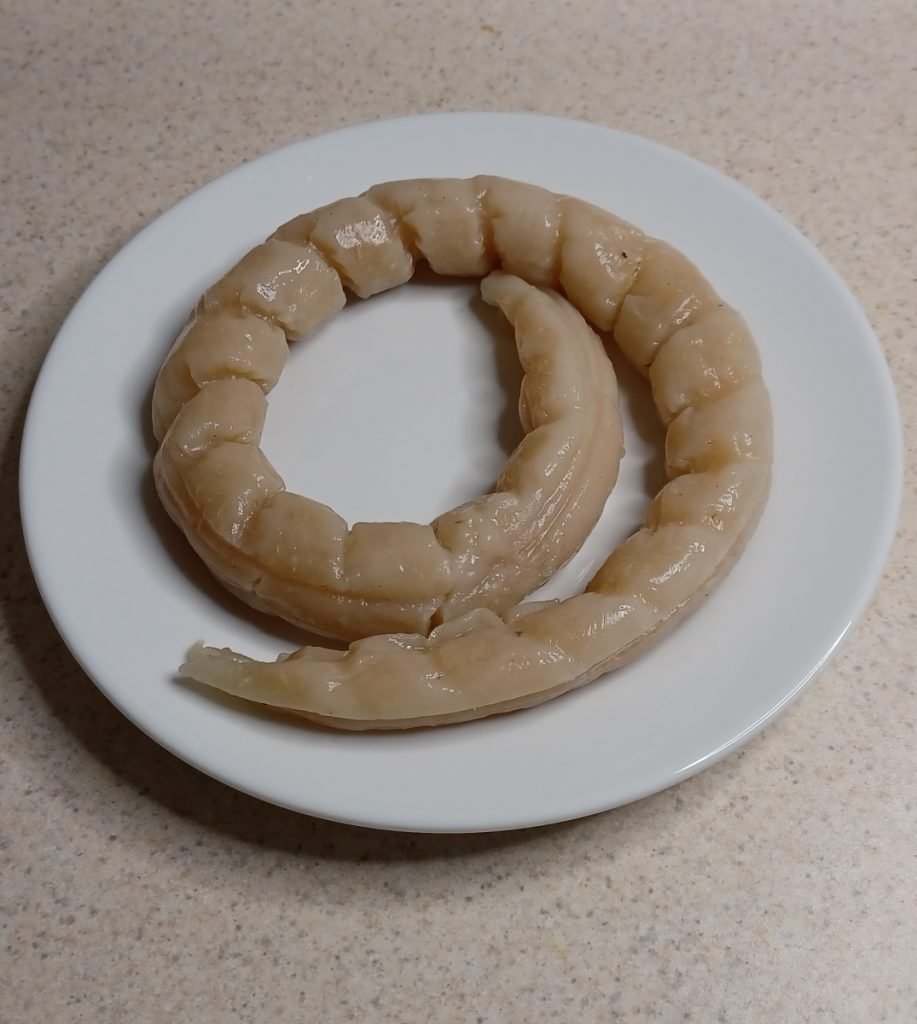
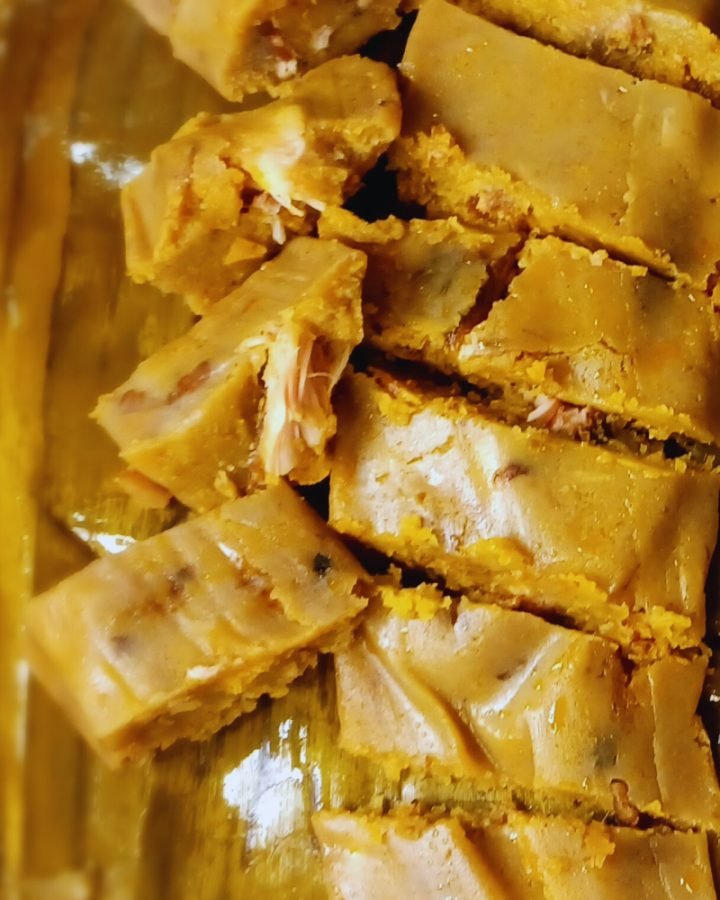
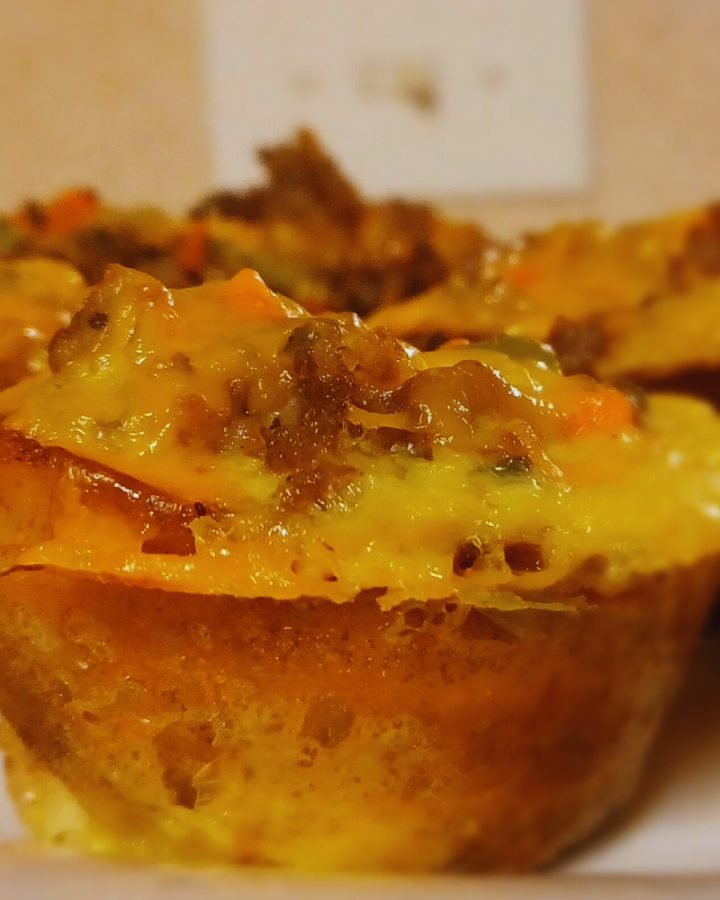
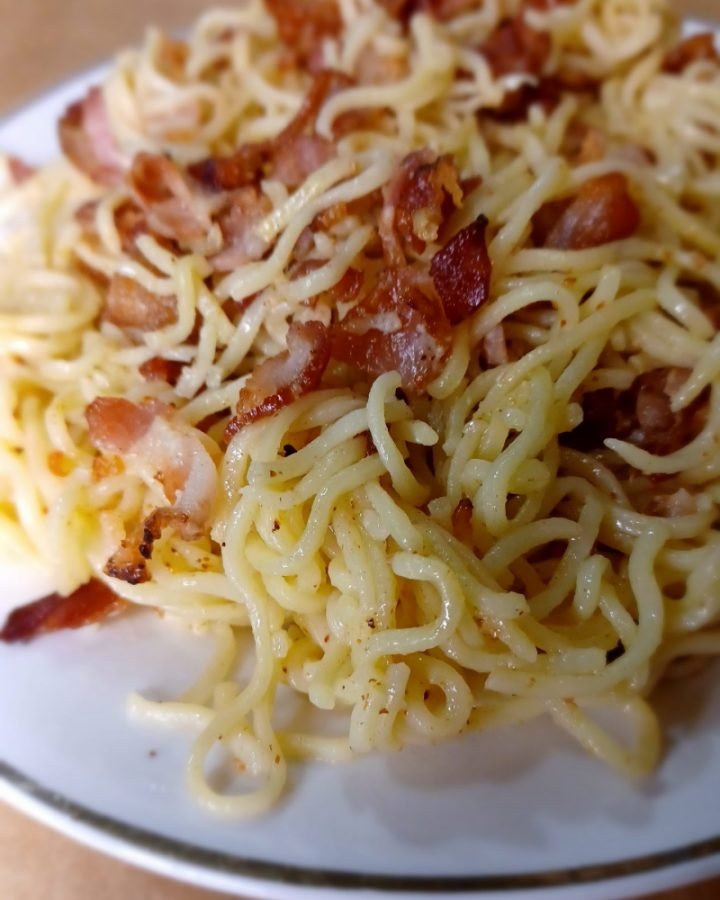
Leave a Reply